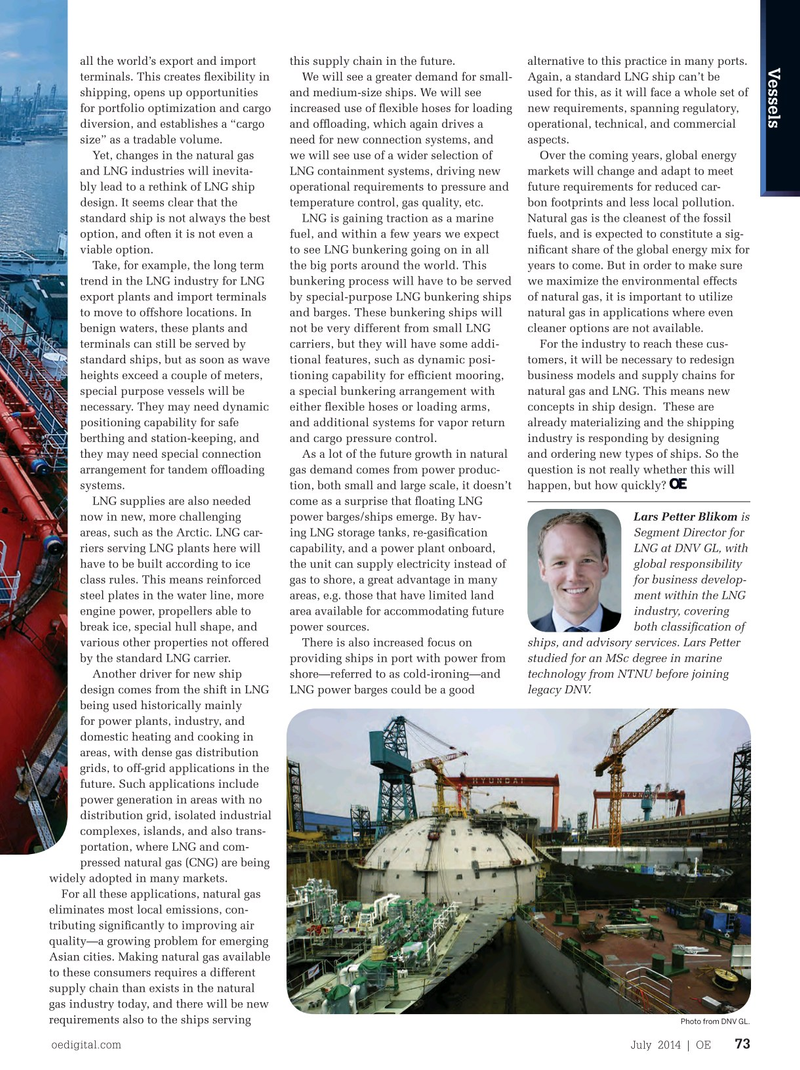
Page 71: of Offshore Engineer Magazine (Jul/Aug 2014)
Read this page in Pdf, Flash or Html5 edition of Jul/Aug 2014 Offshore Engineer Magazine
all the world’s export and import this supply chain in the future. alternative to this practice in many ports.
Vessels terminals. This creates fexibility in We will see a greater demand for small- Again, a standard LNG ship can’t be shipping, opens up opportunities and medium-size ships. We will see used for this, as it will face a whole set of for portfolio optimization and cargo increased use of fexible hoses for loading new requirements, spanning regulatory, diversion, and establishes a “cargo and offoading, which again drives a operational, technical, and commercial size” as a tradable volume. need for new connection systems, and aspects.
Yet, changes in the natural gas we will see use of a wider selection of Over the coming years, global energy and LNG industries will inevita- LNG containment systems, driving new markets will change and adapt to meet bly lead to a rethink of LNG ship operational requirements to pressure and future requirements for reduced car- design. It seems clear that the temperature control, gas quality, etc. bon footprints and less local pollution. standard ship is not always the best LNG is gaining traction as a marine Natural gas is the cleanest of the fossil option, and often it is not even a fuel, and within a few years we expect fuels, and is expected to constitute a sig- viable option. to see LNG bunkering going on in all nifcant share of the global energy mix for
Take, for example, the long term the big ports around the world. This years to come. But in order to make sure trend in the LNG industry for LNG bunkering process will have to be served we maximize the environmental effects export plants and import terminals by special-purpose LNG bunkering ships of natural gas, it is important to utilize to move to offshore locations. In and barges. These bunkering ships will natural gas in applications where even benign waters, these plants and not be very different from small LNG cleaner options are not available. terminals can still be served by carriers, but they will have some addi- For the industry to reach these cus- standard ships, but as soon as wave tional features, such as dynamic posi- tomers, it will be necessary to redesign heights exceed a couple of meters, tioning capability for effcient mooring, business models and supply chains for special purpose vessels will be a special bunkering arrangement with natural gas and LNG. This means new necessary. They may need dynamic either fexible hoses or loading arms, concepts in ship design. These are positioning capability for safe and additional systems for vapor return already materializing and the shipping berthing and station-keeping, and and cargo pressure control. industry is responding by designing they may need special connection As a lot of the future growth in natural and ordering new types of ships. So the arrangement for tandem offoading gas demand comes from power produc- question is not really whether this will systems. tion, both small and large scale, it doesn’t happen, but how quickly?
LNG supplies are also needed come as a surprise that foating LNG now in new, more challenging power barges/ships emerge. By hav- Lars Petter Blikom is areas, such as the Arctic. LNG car- ing LNG storage tanks, re-gasifcation Segment Director for riers serving LNG plants here will capability, and a power plant onboard, LNG at DNV GL, with have to be built according to ice the unit can supply electricity instead of global responsibility class rules. This means reinforced gas to shore, a great advantage in many for business develop- steel plates in the water line, more areas, e.g. those that have limited land ment within the LNG engine power, propellers able to area available for accommodating future industry, covering break ice, special hull shape, and power sources. both classifcation of various other properties not offered There is also increased focus on ships, and advisory services. Lars Petter by the standard LNG carrier. providing ships in port with power from studied for an MSc degree in marine
Another driver for new ship shore—referred to as cold-ironing—and technology from NTNU before joining design comes from the shift in LNG LNG power barges could be a good legacy DNV.
being used historically mainly for power plants, industry, and domestic heating and cooking in areas, with dense gas distribution
Enter the specialized grids, to off-grid applications in the future. Such applications include power generation in areas with no distribution grid, isolated industrial complexes, islands, and also trans- portation, where LNG and com- pressed natural gas (CNG) are being widely adopted in many markets.
For all these applications, natural gas eliminates most local emissions, con- tributing signifcantly to improving air quality—a growing problem for emerging
Asian cities. Making natural gas available to these consumers requires a different supply chain than exists in the natural gas industry today, and there will be new requirements also to the ships serving
Photo from DNV GL. oedigital.com July 2014 | OE 73 000_OE0714_Vessels.indd 73 6/20/14 5:24 PM

 70
70

 72
72